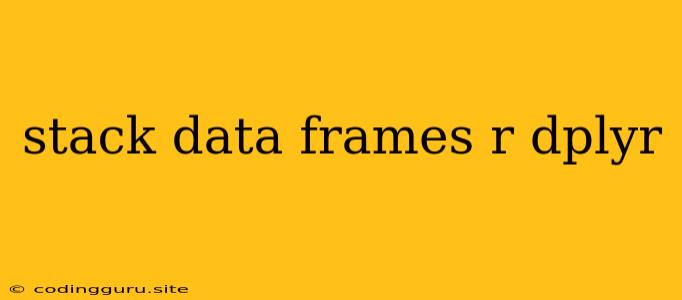Stacking Data Frames in R with dplyr: A Comprehensive Guide
Data wrangling is an essential part of any data analysis workflow. Often, we find ourselves working with data that's not in the format we need for our analysis. One common challenge is dealing with data that's spread across multiple columns, which can make it difficult to work with. This is where stacking data frames in R comes in.
Stacking data frames essentially transforms your data from a wide format (multiple columns) to a long format (one or two columns, with a column indicating the original variable name). This can be incredibly useful for various tasks, like plotting, modeling, and summarizing data.
Why Use dplyr for Stacking Data Frames?
The dplyr package is a powerful tool for data manipulation in R. It provides a concise and expressive syntax for a wide range of data transformation tasks, including stacking data frames.
How to Stack Data Frames with dplyr
The primary function in dplyr for stacking data frames is pivot_longer(). Let's break down how to use it:
1. Loading Necessary Packages
First, load the dplyr package:
library(dplyr)
2. Creating a Sample Data Frame
Let's create a simple data frame to work with:
data <- data.frame(
name = c("Alice", "Bob", "Charlie"),
age = c(25, 30, 28),
height = c(165, 178, 182)
)
3. Stacking the Data Frame
Now, we use pivot_longer() to stack the data frame:
stacked_data <- data %>%
pivot_longer(cols = c(age, height),
names_to = "variable",
values_to = "value")
Explanation:
pivot_longer(): This function is the heart of the stacking process.cols = c(age, height): This specifies the columns to be stacked (in our case, theageandheightcolumns).names_to = "variable": This indicates that the column names (ageandheight) should be placed in a new column called "variable".values_to = "value": This indicates that the actual values from the stacked columns should be placed in a new column called "value".
4. Examining the Stacked Data Frame
Let's print the stacked data frame to see the results:
print(stacked_data)
The output will look like this:
name variable value
1 Alice age 25
2 Bob age 30
3 Charlie age 28
4 Alice height 165
5 Bob height 178
6 Charlie height 182
As you can see, the data is now stacked in a long format. The original column names are now stored in the "variable" column, and the actual values are stored in the "value" column.
Tips and Considerations:
- Multiple Columns: You can stack multiple columns by including them in the
colsargument. - Order: The
pivot_longer()function stacks columns in the order specified in thecolsargument. - Custom Column Names: You can use different names for the
names_toandvalues_toarguments to suit your needs.
Advanced Usage of pivot_longer()
pivot_longer() offers several additional features for more complex data manipulation. Here are a few examples:
- Filtering Columns: You can filter the columns you want to stack using the
names_patternargument. - Adding Prefixes or Suffixes: You can use the
names_prefixandnames_suffixarguments to add prefixes or suffixes to the new variable names. - Changing Column Order: The
names_transformargument allows you to customize the order of the new variable names.
Examples of Data Stacking Use Cases:
- Visualizations: Stacking data frames is essential for creating various types of plots, such as boxplots, bar charts, and line graphs.
- Modeling: You can stack data for regression models, particularly when you have multiple independent variables that need to be treated as separate levels within a single variable.
- Analysis: Stacking data can facilitate analysis by combining multiple columns into a single column, simplifying calculations and comparisons.
Conclusion
Stacking data frames in R using dplyr's pivot_longer() function is a powerful and efficient technique. It allows you to transform your data from a wide format to a long format, making it easier to work with for various tasks. By mastering this technique, you can significantly streamline your data analysis workflow and unlock new insights from your data.
